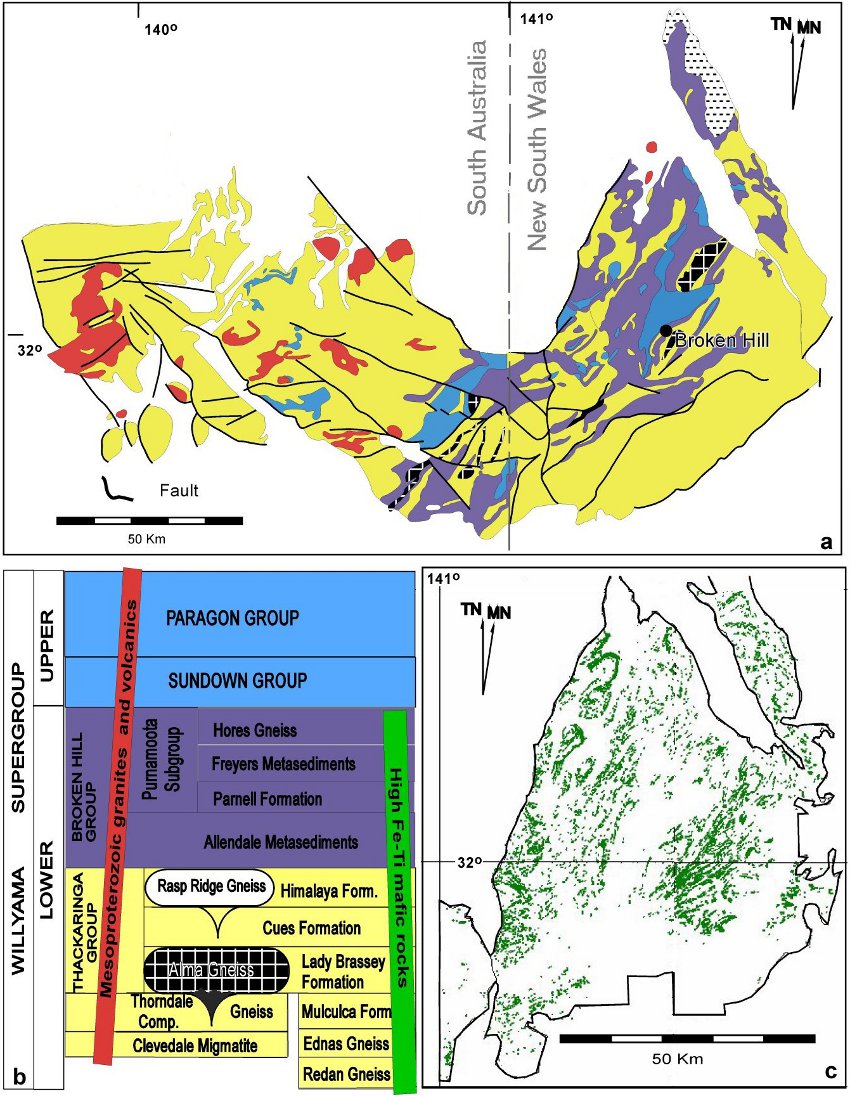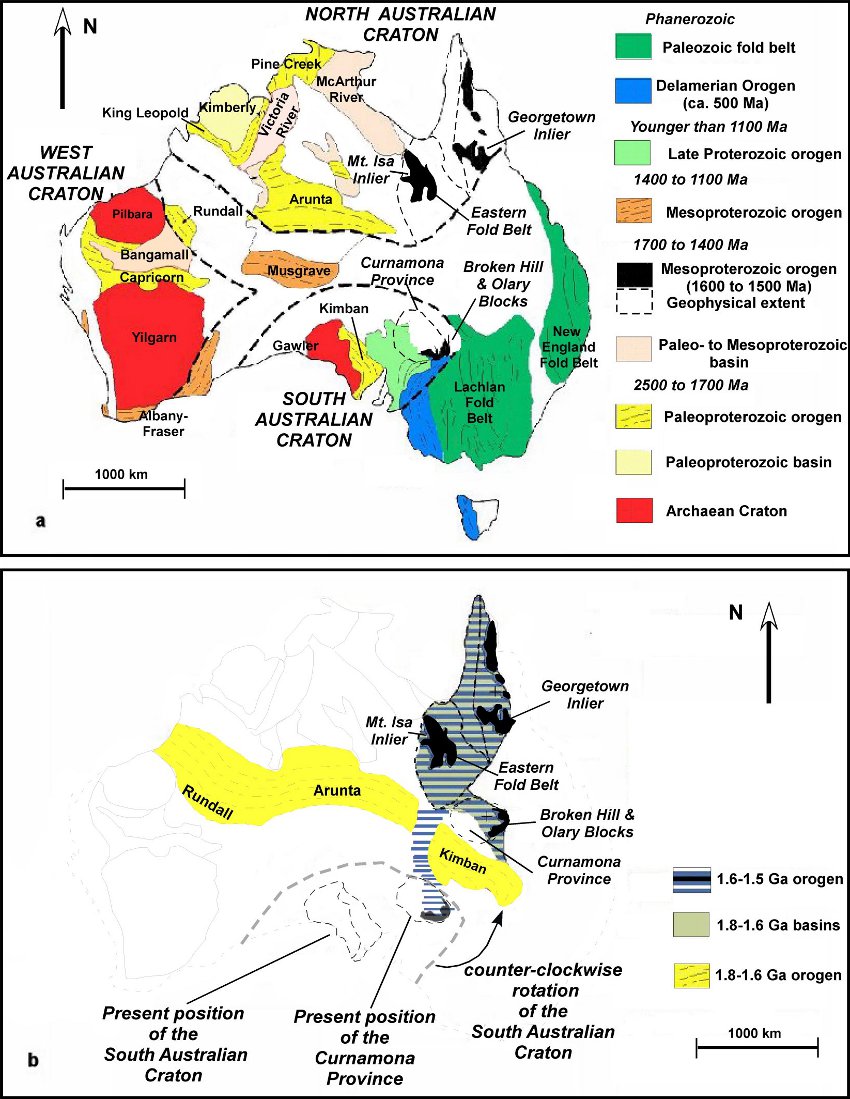December 2007 LIP of the Month
The high Fe-Ti mafic magmatism in the Paleoproterozoic Broken Hill Block of the Curnamona Province, southeastern Australia, as part of a Large Igneous Province?
Massimo Raveggi
Australian Crustal Research Centre
School of Geosciences
Monash University
3800 Victoria, Australia
David Giles
South Australian Centre for Mineral Exploration Under Cover
School of Earth & Environmental Sciences
University of Adelaide
5005 South Australia, Australia
John Foden
Continental Evolution Research Group
School of Earth & Environmental Sciences
University of Adelaide
5005 South Australia, Australia
Mike Raetz
Australian Crustal Research Centre
School of Geosciences
Monash University
3800 Victoria, Australia
Contributed by Massimo Raveggi
Abstract
The metasedimentary sequences of the Willyama Supergroup in the Broken Hill Block of the Curnamona Province in western NSW (Fig. 1), Australia were intruded at ca. 1685 Ma by high Fe-Ti mafic rocks. These unusual lithologies occur throughout the lower Willyama Supergroup stratigraphy (Fig. 2) and are interpreted here as shallowly emplaced sills that were metamorphosed to upper amphibolite and granulite facies during the Olarian Orogeny (ca. 1600-1580 Ma). Our data indicate that the high Fe-Ti mafic meta-igneous rocks originated as a result of variable degrees of partial melting of a depleted mantle source, but slightly enriched with incompatible elements compared to present day N-MORB. This was followed by simple crystal fractionation or by an AFC (assimilation-fractional crystallisation) process involving only small degrees of crustal assimilation (rate of assimilation to rate of crystal fractionation, r = 0.05-0.2). Crystal fractionation proceeded along a tholeiitic trend of extreme primary iron and titanium enrichment, leading to melts with up to 25 wt % of total iron as Fe2O3 and 4.2 wt % of TiO2. Volumetrically, minor intermediate rocks evolved from this fractionation, but the bulk of the contemporary felsic magmatic rocks (Rasp Ridge and Hores/Potosi Gneisses) are not linked by fractional crystallisation to the mafic melt that produced the meta-igneous high Fe-Ti mafic rocks and are products of the anatexis of crustal material from the Willyama sedimentary pile. Based on the occurrence of bimodal magmatism, a depleted mantle source, partial melting modelling and minimal crustal contamination of the mafic rocks, we infer that the Broken Hill Block (ca. 1685 Ma) was the extensional axis and depositional centre of an advanced stage intra-cratonic rift with relatively thin crust and lithosphere. Data from the neighbouring Olary Domain, in contrast, imply smaller degrees of partial melting, higher degrees of crustal contamination and the presence of a subcontinental lithospheric mantle source, which suggests relatively thicker lithosphere and places the Olary Domain on the rift margin (Raveggi et al., 2007).
Bryan and Ernst (2008) defined a Large Igneous Province as follows: area extents >1 Mkm2; igneous volumes > 0.1 Mkm3 with igneous pulse(s) of short duration (~1 to 5 Ma) during which > 75% of the total igneous volume has been emplaced; a maximum lifespan of ~50 Ma; intraplate tectonic settings. The Curnamona Province loosely fits this definition of Large Igneous Province. The extension of the Curnamona Province is not comparable to the one of Large Igneous Provinces and the high Fe-Ti mafic rocks are volumetrically subordinate in the stratigraphic sequence and manly occur in the Broken Hill Block. Nevertheless the magmatic activity occurred in an intra-continental rift setting and the bulk of the high Fe-Ti mafic rocks intruded in a relatively short time period of time at ca. 1685 Ma (see Raveggi et al., 2007 for a review of the geochronology of these rocks). This is indeed comparable to other Large Igneous Provinces.
Several authors have pointed out the lithological, geochronological, metamorphic and metallogenic similarities between the Broken Hill Block, the Eastern Fold Belt of the southeastern margin of the Mount Isa Inlier and the Georgetown Inlier (Fig. 3a) of North Queensland (Black et al., 1998; Page and Sun 1998; Williams, 1998; Giles and Nutman, 2003; Hills, 2003; Giles et al., 2004; Page et al., 2005). Importantly, the three terranes are characterised by the presence of broadly coeval high Fe-Ti mafic rocks (Withnall, 1985; Williams, 1998; Baker and Crawford, 2006; Raveggi et al., in prep). High Fe-Ti mafic rocks are rare in the geologic record (Raveggi et al., 2007) and their occurrence in the Willyama Supergroup, the Eastern Fold Belt and the Georgetown Inlier provides compelling evidence for a genetic link between magmatism in these terranes. These similarities have lead to paleogeographic reconstructions suggesting that these terranes were much closer in the Paleo- to Mesoproterozoic than what they are now (Fig. 3a and 3b; Giles et al., 2004; Betts and Giles 2006). In this view the Curnamona Province, together with the North Queensland’s Eastern Fold Belt and Georgetown Inlier could possibly represent the erosional remnants or the pieces of a Large Igneous Province fragmented by subsequent plate tectonic break-up.

Figure 1: a) Location of the Paleo- to Mesoproterozoic Curnamona Province (Preiss, 1998). b) The Broken Hill Block and Olary Domain (Stevens, 1986; Crooks 2001) and their location in the Curnamona Province. c) Approximate boundaries of the various domains present in the Curnamona Province. The study of Raveggi et al., (2007) focuses on the high Fe-Ti mafic rocks found in the Broken Hill Block and Olary Domain.

Figure 2: a) Simplified geology of the Broken Hill Block and Olary Domain (modified after Willis et al., 1983; Conor, 2000; Crooks, 2002). b) The Willyama Supergroup stratigraphy (modified after Willis et al., 1983). The colours in the geological map are the same to the corresponding stratigraphical unit of the Willyama Supergroup stratigraphy. c) Distribution of the high Fe-Ti mafic rocks in the New South Wales portion of the Broken Hill Block (GSNSW, 2002). The size of the mafic bodies has been exaggerated for clarity and does not correspond to their actual size.

Figure 3: a) Tectonic element map of the Australian continent showing the age of major terranes (modified after Betts and Giles, 2006). b) Reconstruction of the North and South Australian cratons between 1.8 and 1.5 Ga (modified after Giles et al., 2004). The reconstruction involves a ~52° counter-clockwise rotation of the South Australian Craton with respect to the North Australian Craton, placing the Curnamona Province adjacent to the Eastern Fold Belt of the Mount Isa Inlier.
References
Baker, M. J. and Crawford, A. J. 2006. Geochemistry of the Fe-rich tholeiites from the Georgetown Inlier; North Queensland: implications for the relationship with the Broken Hill and Mt Isa sequences: Abstracts from the Australian Earth Sciences Convention, Melbourne Australia, p. 68.
Betts, P. G. and Giles, D. 2006. The 1800-1100 Ma tectonic evolution of Australia: Precambrian Research, v. 144, p. 92-125.
Black, L. P., Gregory, P., Withnall, I. W. and Bain, J. H. C., 1998. U-Pb zircon age for the Etheridge Group, Georgetown region, North Queensland: implications for relationships with the Broken Hill and Mt Isa sequences: Australian Journal of Earth Sciences, v. 45, p. 925-935.
Bryan, S. E. and Ernst, R. E. 2008. Revised definition of Large Igneous Provinces (LIPs): Earth-Science Reviews, v. 86, p. 175-202.
Conor, C.H.H., 2000. Definition of major sedimentary and igneous units of the Olary Domain, Curnamona Province. MESA Journal, 19: 51-56.
Conor, C.H.H., 2000. Definition of major sedimentary and igneous units of the Olary Domain, Curnamona Province. MESA Journal, 19: 51-56.
Crooks, A.F., 2001. Olary-Broken Hill Domain boundary – Mingary 1:100000 map area, Curnamona Province. MESA Journal, 20: 44-45.
Crooks, A.F., 2002. Mafic rocks of the Mingary 1:100 000 map area — a review. Primary Industries and Resources South Australia. Report Book 2002/027.
Giles, D., Betts, P. G. and Lister, G. S., 2004. 1.8-1.5-Ga links between the North and South Australian Cratons and the Early-Middle Proterozoic configuration of Australia: Tectonophysics, v. 380, p. 27-41.
Giles, D. and Nutman, A. P., 2003. SHRIMP U-Pb zircon dating of the host rocks of the Cannington Ag-Pb-Zn deposit, southeastern Mt Isa Block, Australia: Australian Journal of Earth Sciences, v. 50, p. 295-309.
GSNSW, 2002. Broken Hill geoscience database. Product of the Broken Hill Exploration Initiative. Mineral Resources of New South Wales, Geological Survey of New South Wales, Version 2.
Hills, Q., 2003. The deformation and metamorphic history of the Georgetown Inlier, North Queensland: implications for the 1.7 to 1.5 Ga tectonic evolution of northeastern Proterozoic Australia: Unpublished PhD thesis, Monash University, Melbourne, Australia, p. 212.
Page, R. W. and Sun, S.-s., 1998. Aspects of geochronology and crustal evolution in the Eastern Fold Belt, Mt isa Inlier: Australian Journal of Earth Sciences, v. 45, p. 343-361.
Page, R. W., Conor, C. H. H., Stevens, B. P. J., Gibson, G. M., Preiss, W. V. and Southgate, P. N., 2005. Correlation of Olary and Broken Hill domains, Curnamona Province: possible relationship to Mount Isa and other North Australian Pb-Zn-Ag bearing successions: Economic Geology, v. 100, p. 663-676.
Preiss, W.V., 1998. Overview of the Curnamona Province and its Tectonic Setting. Abstracts from Broken Hill Exploration Initiative annual meeting, 1998. Australian Geological Survey Organisation Record 1998/25: 94-97.
Raveggi, M., Giles, D., Foden, J., and Raetz, M., 2007. High Fe-Ti mafic magmatism and tectonic setting of the Broken Hill Block, N.S.W. Australia: Precambrian Research, v. 156, p. 55-84.
Raveggi, M., Giles, D., Foden, J. and Raetz, M. in prep. Geochemistry of the high Fe-Ti mafic magmatism in the Paleoproterozoic Eastern Fold Belt, Mount Isa Inlier, Australia: implications for its tectonic evolution.
Stevens, B.P.J., 1986. Post depositional history of the Willyama Supergroup in the Broken Hill Block. Australian Journal of Earth Sciences, 3: 73-98.
Williams, P. J., 1998. Magmatic iron enrichment in high-iron metatholeiites associated with ' Broken Hill-type ' Pb-Zn-Ag deposits, Mt Isa Eastern Succession: Australian Journal of Earth Sciences., v. 45, p. 389-396.
Willis, I.L., Brown, R.E., Stroud, W.J. and Stevens, B.P.J., 1983. The Early Proterozoic Willyama Supergroup: stratigraphic subdivision and interpretation of high to low-grade metamorphic rocks in the Broken Hill Block, New South Wales. Journal of the Geological Society of Australia, 30: 195-224.
Withnall, I. W., 1985. Geochemistry and tectonic significance of Proterozoic mafic rocks from the Georgetown Inlier, north Queensland: BMR Journal of Australian Geology and Geophysics, v. 9, p. 339-351.
